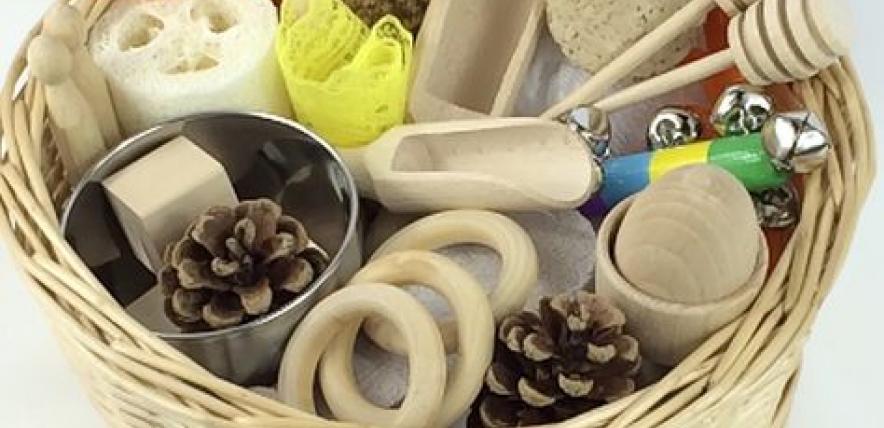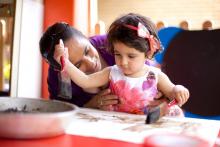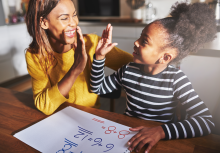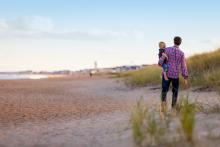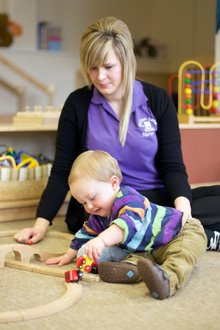Children’s interest in collections of household objects date back centuries and provide endless fascination for babies and toddlers. Here’s how to create a treasure basket made up of natural objects that will help stimulate your babies’ senses – along with tips on how on keep the awe and wonder of exploring natural objects alive all the way through to toddlerhood.
By Nicole Weinstein
It's your child's birthday. You spent ages choosing the perfect gift only for your two-year-old to glance at the present and then be much more interested in playing with the box and the wrapping paper!
Most parents will be able to relate — not that it will deter many of us from buying the latest toys on the market!
But it’s useful to understand why children prefer the box to the toy and why it’s important to offer them opportunities to play with real objects and materials such as wooden spoons, shells and stones that they can explore with all their senses.
Not only will these experiences nourish their brain but they have the added bonus of holding their interest for much longer periods of time than some commercial toys.
Where do I start with heuristic play?
The age of your child will determine what experience to offer your child:
- Treasure basket play is for babies who can sit up but not yet crawl.
- Heuristic play, which comes from the Greek word to 'discover', is more appropriate for toddlers who are mobile.
Both concepts are tried and tested and were pioneered by Elinor Goldschmied in the 1940s when she observed children's natural interest in collections of household objects. Her work has inspired many parents around the world to develop their own versions of the treasure basket and build up collections of natural and household objects, which is known as heuristic play.
What is a treasure basket?
A treasure basket contains household, natural and recycled objects that are attractive to babies.
It’s full to the brim so that babies can delve in, select what appeals to them and explore the texture, weight, shape, size and smell of the objects.
Offering them a collection of objects that they can suck, lick, smell, bang, pick up and drop, helps develop the pathways in their brains.
And because babies process information through touch and by putting things in their mouth, natural materials like a loofah or a lemon will provide them with rich sensory feedback.
There are many ready-made treasure baskets on the market but it’s easy - and fun - to create your own:
How to create a treasure basket
- You will need a round, low-sided basket, ideally made out of wicker.
- If you don’t have a basket, you can use a low-sided robust cardboard box or simply put the items in a pile on the floor.
- Carefully select a range of about 30 objects that are safe for your babies to handle and put in their mouth.
- Ensure that the objects are not sharp or too small that they could choke on them. Regularly check them for safety hazards.
What should I put in it?
Traditionally, treasure baskets contain only natural products but if you don’t have solely natural product to hand, go for a mix of objects that your child is interested in. For example, if they like brushes, there’s no harm including a plastic-handled brush.
- Include wooden spoons; cotton reels; a selection of brushes; wooden curtain rings; large shells; keys; metal spoons; metal bowls; spice and herb bags (carefully secured); small wooden bowls; a tea strainer; a large flat pebble; a cork coaster and a whole lemon.
- Add pieces of fabric – scarves; ribbons; knitted coasters.
- Try adding rubber balls with bumpy surfaces - babies are interested in the texture and like to put them in their mouths - or rubber cooking spatulas.
- Search out interesting objects from hardware shops, market stalls and when on holiday.
What’s my role?
It’s important to set aside some quiet time for this activity. Lay out a blanket on the floor and place your child next to the treasure basket. Your child will be deeply engrossed in this play and ideally, they will be able to explore the contents of the basket without interruption.
The parent’s role is to watch and observe. Offer them a friendly smile if they look to you for encouragement. Be on hand to help them but don’t to interrupt or lead their play.
Heuristic play
This is the next step up from treasure basket play for toddlers who are more mobile and want to explore what happens to the natural materials above when they are slotted into containers; stacked up; paired up; graded into size order or colour-matched.
You may have noticed that your toddler is interested in posting letters, for example, or hiding toys around the house. Or they may love banging on saucepans!
This is all part of their natural discovery of the world around them and heuristic play can help facilitate this.
What does it involve?
Unlike treasure basket play, which includes one or a few of each item, heuristic play involves building up multiple collections of the same objects.
- Build up a collection of interesting shells; stones; chains; scarves; ribbons; pegs or pine cones and store them in bags or small baskets. Aim for around 10 of each item.
- Go with your child’s interests. Perhaps they are fascinated with the bangle on your arm. Source a selection of cheap bangles from charity shops or eBay and provide a mug tree alongside it so that they can pile up the bangles, listening to the sounds that they different materials make as they land on top of each other.
- When playing with these items, offer a range of containers such as cardboard household tubes; boxes; bags; wallets and plastic bottles.
- Let them explore putting woollen pom-poms into a cardboard tube; pouring items such as very large buttons from one container to another or the sounds that different pans make when hit with wooden or metal spoons.
- Give them a space and time to explore these activities in their own time, at their own space. As with treasure basket play, be a watchful observer.
Both treasure baskets and heuristic play give your child the opportunity to exercise choice about what object to play with and how to play with it.
When a child plays in this way alongside a trusted adult and feels safe, they are more likely to explore more.
This article was written for the Early Years Alliance by early years journalist Nicole Weinstein
Where next?
7 ways poems and rhymes benefit your child's development
What is mark making and why is it important?

